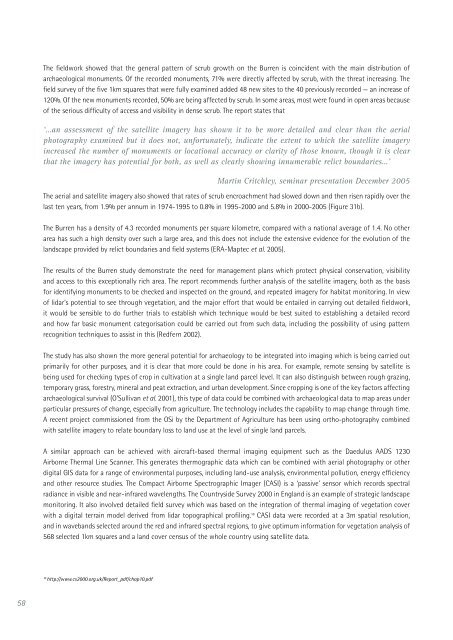Aerial Archaeology in Ireland - The Heritage Council
Aerial Archaeology in Ireland - The Heritage Council
Aerial Archaeology in Ireland - The Heritage Council
Create successful ePaper yourself
Turn your PDF publications into a flip-book with our unique Google optimized e-Paper software.
58<br />
<strong>The</strong> fieldwork showed that the general pattern of scrub growth on the Burren is co<strong>in</strong>cident with the ma<strong>in</strong> distribution of<br />
archaeological monuments. Of the recorded monuments, 71% were directly affected by scrub, with the threat <strong>in</strong>creas<strong>in</strong>g. <strong>The</strong><br />
field survey of the five 1km squares that were fully exam<strong>in</strong>ed added 48 new sites to the 40 previously recorded — an <strong>in</strong>crease of<br />
120%. Of the new monuments recorded, 50% are be<strong>in</strong>g affected by scrub. In some areas, most were found <strong>in</strong> open areas because<br />
of the serious difficulty of access and visibility <strong>in</strong> dense scrub. <strong>The</strong> report states that<br />
‘…an assessment of the satellite imagery has shown it to be more detailed and clear than the aerial<br />
photography exam<strong>in</strong>ed but it does not, unfortunately, <strong>in</strong>dicate the extent to which the satellite imagery<br />
<strong>in</strong>creased the number of monuments or locational accuracy or clarity of those known, though it is clear<br />
that the imagery has potential for both, as well as clearly show<strong>in</strong>g <strong>in</strong>numerable relict boundaries…’<br />
Mart<strong>in</strong> Critchley, sem<strong>in</strong>ar presentation December 2005<br />
<strong>The</strong> aerial and satellite imagery also showed that rates of scrub encroachment had slowed down and then risen rapidly over the<br />
last ten years, from 1.9% per annum <strong>in</strong> 1974-1995 to 0.8% <strong>in</strong> 1995-2000 and 5.8% <strong>in</strong> 2000-2005 (Figure 31b).<br />
<strong>The</strong> Burren has a density of 4.3 recorded monuments per square kilometre, compared with a national average of 1.4. No other<br />
area has such a high density over such a large area, and this does not <strong>in</strong>clude the extensive evidence for the evolution of the<br />
landscape provided by relict boundaries and field systems (ERA-Maptec et al. 2005).<br />
<strong>The</strong> results of the Burren study demonstrate the need for management plans which protect physical conservation, visibility<br />
and access to this exceptionally rich area. <strong>The</strong> report recommends further analysis of the satellite imagery, both as the basis<br />
for identify<strong>in</strong>g monuments to be checked and <strong>in</strong>spected on the ground, and repeated imagery for habitat monitor<strong>in</strong>g. In view<br />
of lidar‘s potential to see through vegetation, and the major effort that would be entailed <strong>in</strong> carry<strong>in</strong>g out detailed fieldwork,<br />
it would be sensible to do further trials to establish which technique would be best suited to establish<strong>in</strong>g a detailed record<br />
and how far basic monument categorisation could be carried out from such data, <strong>in</strong>clud<strong>in</strong>g the possibility of us<strong>in</strong>g pattern<br />
recognition techniques to assist <strong>in</strong> this (Redfern 2002).<br />
<strong>The</strong> study has also shown the more general potential for archaeology to be <strong>in</strong>tegrated <strong>in</strong>to imag<strong>in</strong>g which is be<strong>in</strong>g carried out<br />
primarily for other purposes, and it is clear that more could be done <strong>in</strong> his area. For example, remote sens<strong>in</strong>g by satellite is<br />
be<strong>in</strong>g used for check<strong>in</strong>g types of crop <strong>in</strong> cultivation at a s<strong>in</strong>gle land parcel level. It can also dist<strong>in</strong>guish between rough graz<strong>in</strong>g,<br />
temporary grass, forestry, m<strong>in</strong>eral and peat extraction, and urban development. S<strong>in</strong>ce cropp<strong>in</strong>g is one of the key factors affect<strong>in</strong>g<br />
archaeological survival (O’Sullivan et al. 2001), this type of data could be comb<strong>in</strong>ed with archaeological data to map areas under<br />
particular pressures of change, especially from agriculture. <strong>The</strong> technology <strong>in</strong>cludes the capability to map change through time.<br />
A recent project commissioned from the OSi by the Department of Agriculture has been us<strong>in</strong>g ortho-photography comb<strong>in</strong>ed<br />
with satellite imagery to relate boundary loss to land use at the level of s<strong>in</strong>gle land parcels.<br />
A similar approach can be achieved with aircraft-based thermal imag<strong>in</strong>g equipment such as the Daedulus AADS 1230<br />
Airborne <strong>The</strong>rmal L<strong>in</strong>e Scanner. This generates thermographic data which can be comb<strong>in</strong>ed with aerial photography or other<br />
digital GIS data for a range of environmental purposes, <strong>in</strong>clud<strong>in</strong>g land-use analysis, environmental pollution, energy efficiency<br />
and other resource studies. <strong>The</strong> Compact Airborne Spectrographic Imager (CASI) is a ‘passive’ sensor which records spectral<br />
radiance <strong>in</strong> visible and near-<strong>in</strong>frared wavelengths. <strong>The</strong> Countryside Survey 2000 <strong>in</strong> England is an example of strategic landscape<br />
monitor<strong>in</strong>g. It also <strong>in</strong>volved detailed field survey which was based on the <strong>in</strong>tegration of thermal imag<strong>in</strong>g of vegetation cover<br />
with a digital terra<strong>in</strong> model derived from lidar topographical profil<strong>in</strong>g. 10 CASI data were recorded at a 3m spatial resolution,<br />
and <strong>in</strong> wavebands selected around the red and <strong>in</strong>frared spectral regions, to give optimum <strong>in</strong>formation for vegetation analysis of<br />
568 selected 1km squares and a land cover census of the whole country us<strong>in</strong>g satellite data.<br />
10 http://www.cs2000.org.uk/Report_pdf/chap10.pdf

















